Posted by Anita on 01.12.09 7:22 PM
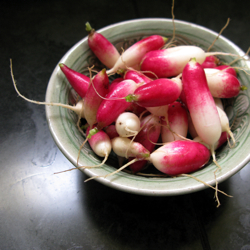 After two-plus weeks in London, we knew it was going to be difficult to get back to the grind, and the cold, grey weather here in San Francisco wasn’t doing anything to help us get over our jetlag.
After two-plus weeks in London, we knew it was going to be difficult to get back to the grind, and the cold, grey weather here in San Francisco wasn’t doing anything to help us get over our jetlag.
In a rare fit of travel wisdom, I’d planned our return for Saturday, to give us time to do little things like food shopping and laundry before heading back to work. But we arrived home far too late to get to our usual market at the Ferry Plaza, and the idea of trudging through a brightly lit supermarket didn’t seem the slightest bit appealing.
So after a fortifying Sunday morning breakfast, we headed across the Golden Gate bridge, in search of the Marin Civic Center farmers market. Even though this market isn’t much further from home than the downtown Berkeley market, we’d never checked it out. What we found was pretty impressive: A good number of stalls — maybe close to 100 — with a lot of variety, even in the middle of winter.
 We certainly had no problem finding meat. Marin Sun Farms was there, as were the Prather Ranch boys and Devil’s Gulch Ranch — a name we’ve seen on menus, but never bought; they don’t sell at the SF markets. By the time we arrived, all they had left was a big five-pound pork shoulder roast. We hemmed and hawed, then decided that we could make a big batch of carnitas and save the leftovers for a later meal. A vendor from San Luis Obispo — technically outside our challenge radius, but we fudged it — was selling avocados, and a bakery from Sacramento had corn tortillas; we’d made the right decision.
We certainly had no problem finding meat. Marin Sun Farms was there, as were the Prather Ranch boys and Devil’s Gulch Ranch — a name we’ve seen on menus, but never bought; they don’t sell at the SF markets. By the time we arrived, all they had left was a big five-pound pork shoulder roast. We hemmed and hawed, then decided that we could make a big batch of carnitas and save the leftovers for a later meal. A vendor from San Luis Obispo — technically outside our challenge radius, but we fudged it — was selling avocados, and a bakery from Sacramento had corn tortillas; we’d made the right decision.
We also picked up a pretty bone-in pork chop from Marin Sun, plus the usual assortment of vegetables and starches. Once we returned home, I popped the pork chop in my usual cider brine for a few hours. For our first Challenge meal of the week, we served it with mashed potatoes and a really nice chopped salad of romaine, avocado, radishes, carrots, and cucumbers, all tossed in a citrusy dressing and topped with grated dry Jack. (I was mimicking a salad I used to love ordering at Two before they went downhill, and I think I got pretty darned close.)
Every time I opened the fridge, that enormous pork shoulder was staring back at me. With a full week of evening commitments ahead, I quickly figured out that I’d bitten off more than I could chew; there just wasn’t time in our schedule for the full evening of patient simmering that carnitas requires. And with a slate of office projects piling up, there was no way I could work from home to coddle it.
I wondered aloud if the Crock-Pot might offer a solution, and Cameron agreed that it might be worth a try. “The worst thing that happens is you end up with pork stew.” A quick cruise around the Web didn’t really turn up much in the way of a trustworthy recipe, so I decided to wing it. I used our usual carnitas recipe, with a couple of changes: I left the meat in larger chunks to combat the tendency for everything to turn to mush. I also reduced the liquid — slow cookers retain a lot more moisture than even the best-sealed pots — and kicked up the brightness with a little citrus, to compensate for slow cooking’s flavor-dulling effect.
I’d popped the ingredients in the pot, then headed to the office, fully expecting to return home in about 8 hours to keep an eye on the tail end of the cooking process. Naturally, work dramas conspired against me, so it was nearly 12 hours later that I walked in the front door. A heavenly smell from the kitchen relieved some of my fears that I’d created a pile of overcooked, dry slop.
I shouldn’t have fretted. The part of the meat that wasn’t submerged got pretty toasty… an unexpected bonus. The rest of the meat was perfectly cooked, juicy and tender, with just enough connective tissue left to keep things together until you hit it with a fork.
In a traditional carnitas recipe, the braising liquid gets simmered down — with the meat in it — at the end of the cooking process; the meat gets nice and crispy in the fat that remains after the broth simmers away. To simulate this effect, we drained the juices and skimmed off the fat to sear the meat. And as a bonus, we have an ice-cube tray full of really yummy pork broth.

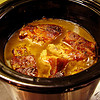
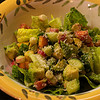

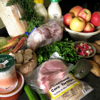
Crock-Pot Carnitas
4 pound boneless pork shoulder
1T whole cumin seed, lightly chopped or crushed
2 bay leaves
1 onion, quartered
1 cup rich pork or chicken stock
1 oz orange juice or Meyer lemon juice
salt, to taste
water, as needed
Cut the pork shoulder into large chunks, and sprinkle with the salt and cumin. Place in the Crock-Pot with the bay, onions, stock, and juice. Add enough water, if needed, to come halfway up the meat. Cover with lid, set pot on low, and cook for 10-12 hours, until meat is very tender.
Remove the meat from the pot and set aside in a warm place. Pour the cooking liquid into a fat separator, let settle, and then pour the defatted broth into a wide pan or baking dish to cool, reserving for another use. (Alternately, use a glass measuring cup and a turkey baster to separate the fat from the broth, or your usual fat-separating method.)
Heat a large skillet, and add enough of the skimmed carnitas fat to the pan to cover the surface well. Pull the meat apart, creating pieces approximately 1 inch long, and add to the pan once the fat is sizzling. Brown the meat until crispy on the outside, turning with tongs as needed. Remove each piece from the pan as it browns on all sides, keeping warm until ready to serve.
Serve with warm tortillas and your choice of condiments: salsa, chopped cilantro and onions, guacamole, sliced radishes, etc.
Dark Days challenge, farmers markets, locavore, meat, recipes
6 Comments »




Posted by Anita on 01.03.09 7:53 PM
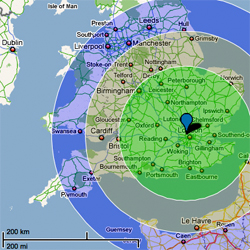 When you live on an island that’s a mere 300 miles wide, local food is a relative thing. In the map to the left, the blue pin shows the location of our London flat. The green circle — which touches the Normandy coast of France — shows a 100-mile radius; yellow encompasses 150 miles, and blue — which grazes Paris! — illustrates the 200-mile radius that many wintertime eat-local challenges allow.
When you live on an island that’s a mere 300 miles wide, local food is a relative thing. In the map to the left, the blue pin shows the location of our London flat. The green circle — which touches the Normandy coast of France — shows a 100-mile radius; yellow encompasses 150 miles, and blue — which grazes Paris! — illustrates the 200-mile radius that many wintertime eat-local challenges allow.
Looks like it would be easy to eat local, doesn’t it? I’m sure with a little practice and a bit of hunting, it definitely could be. But when you’re on holiday and have no understanding of where cities, counties, and postcodes are situated within Britain, it’s definitely a challenge. And when we discovered that most of London’s farmers markets run on a reduced schedule and roster for the run-up to Christmas, we thought we might have to call a vacation hiatus on making our weekly Dark Days meal from all-local ingredients.
Our biggest shock came on an afternoon trip to the world-famous Borough Market, the place we assumed would be the highlight of our shopping excursions. But although it’s still a feast for the eyes, it’s definitely taken on a more-corporate feeling since our last visit. And despite the wealth of delectables on offer, we found it nearly impossible to unearth items grown or produced local to London. One very pleasant exception: Mrs King’s gorgeous raised-crust pork pies are made in the appellation-controlled region of Melton Mowbray, about 90 miles from London.
Most of the bread we found, at Borough and in shops, was baked either on the outskirts of London, or in nearby Oxfordshire. Once we got a little basic geography under our belts, finding local ales and ciders was easy-peasy, even in the big supermarkets. And many well-regarded packaged products — preserves, pickles, mustards, crackers, cookies, and so forth — are made in Britain, if not within southern England per se.
 If you’re willing to leave the foodie haunts and supermarkets behind, the news gets better. FARMA-certified London Farmers’ Markets have some of the most thorough guidelines I’ve ever seen, touching on everything from permissible ingredients in artisan goods to animal welfare to to maximum distances traveled: Everything sold must be “raised, grown, produced, gathered, caught, or baked within 100 miles of the M25”, London’s exterior beltway. Even on a very slow week at the Marylebone Farmers Market, we were able to cobble together a full meal: Sausages (produced on Food Fore Thought‘s East Sussex farm, using their own-raised pork), Brussels sprouts, and potatoes, which we served with a store-bought bottle of real ale from Hook Norton in Oxfordshire, 81 miles from London.
If you’re willing to leave the foodie haunts and supermarkets behind, the news gets better. FARMA-certified London Farmers’ Markets have some of the most thorough guidelines I’ve ever seen, touching on everything from permissible ingredients in artisan goods to animal welfare to to maximum distances traveled: Everything sold must be “raised, grown, produced, gathered, caught, or baked within 100 miles of the M25”, London’s exterior beltway. Even on a very slow week at the Marylebone Farmers Market, we were able to cobble together a full meal: Sausages (produced on Food Fore Thought‘s East Sussex farm, using their own-raised pork), Brussels sprouts, and potatoes, which we served with a store-bought bottle of real ale from Hook Norton in Oxfordshire, 81 miles from London.
And in the world beyond all-local, the news is better still. Even in mainstream supermarkets like Waitrose and Sainsbury’s, it’s easy to find cage-free eggs and pastured chickens; a solid majority of carton eggs sold in the UK are cage-free. Thanks to many campaigns by celebrity chefs like Jamie Oliver and Hugh Fearnley-Whittingstall, Britons are by now far more aware of the intrinsic cruelty of the battery hen system than the average consumer here at home. And in England, organic certification — the kind you see stamped on supermarket chickens — means more. It’s not just a simple matter of feeding Chinese organic soy to your animals; the Soil Association (Britain’s main certification agency) guidelines call not just for a cage-free environment, but true “freedom to range”.
Lest you think this means a giant warehouse with a tiny door to a barren yard, the guidelines actually stipulate that birds may not even be permanently housed, and that their forage must be “well-covered with suitable vegetation”. And SA-certified poultry isn’t just something you’ll find in posh shops: Even on the New Year’s Day bank holiday, we had no trouble finding SA-certified organic chicken parts in a ‘Sainsbury Local’, a neighborhood grocery the size of a 7-11. We couldn’t find any evidence that this meat was local to us, but it was labeled “product of Britain”, as were many meat packages we saw and bought.
Despite handicaps of seasonality and familiarity, I feel like we were able to do quite well, rather easily. It’s hard to ignore the feeling that it feels easier to put together an ethical and reasonably environmentally sensitive meal in London than in nearly any other large city we’ve visited.

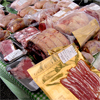

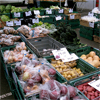

Dark Days challenge, farmers markets, locavore, London
4 Comments »




Posted by Anita on 11.16.08 10:44 PM
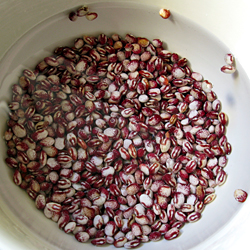 The irony of yesterday’s 80-degree excursion to the Ferry Plaza was that none of us wanted summery stuff. We waltzed right past stalls filled with tomatoes, artichokes, and strawberries(!) and gravitated toward the pork, beans, and greens we all craved despite the heat.
The irony of yesterday’s 80-degree excursion to the Ferry Plaza was that none of us wanted summery stuff. We waltzed right past stalls filled with tomatoes, artichokes, and strawberries(!) and gravitated toward the pork, beans, and greens we all craved despite the heat.
With the unseasonably warm weather and our un-air-conditoned house, we knew it would stay too hot to braise, so we headed over to the Marin Sun Farms stand and checked out their grillable options. Laura picked out a lovely slab of pork ribs, and I walked across the aisle for a bag full of Brussels sprouts from the Iacopi’s stand.
Since Laura’s only able to find pintos and cranberry beans at her local markets, she planned to load up her bag with lots of fun varieties from the Rancho Gordo stand. Little did we know that Steve Sando himself would be tending the stall on Saturday, training two new employees and charming the shoppers who were surprised to see the bean guru himself behind the baskets and bags. In addition to the four varieties Laura chose — old favorites Yellow Eye and Calypso, plus two others that escape me Pebble and Anasazi — we also bought a pound of Red Nightfall, for our Dark Days dinner that night. I had no idea how we’d serve them, but I knew we could find inspiration flipping through our just-bought copy of Steve’s new book, Heirloom Beans.
Cameron gave the ribs a simple rub (salt, pepper, dried sage, and pasilla), and we planned to serve them with a mustard-and-vinegar sauce, so we looked for a simple recipe that would showcase the beans’ natural flavors. It didn’t take us long to find a dish that we all agreed sounded delicious: What’s not to love about porky goodness topped with a drizzle of bright olive oil and a snowy dusting of cheese? We found a hunk of Fatted Calf pancetta in the freezer and snipped some fresh sage from the garden, swapped a red onion for yellow, and left out the original recipe’s carrot. The end result was delicious, if I do say so myself, and a perfect counterpoint to the smokiness of the ribs and the tart-bitterness of the shredded sprouts.
ps: For more great photos of our meal prep, don’t miss Laura’s set and post.
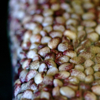

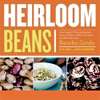
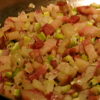
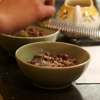
Beans with Pancetta and Sage
– adapted from Heirloom Beans
1/2 pound heirloom beans, soaked
– the original recipe calls for Jacob’s Cattle, but we used Red Nightfall
1/2 medium red onion, chopped
2 celery stalks, chopped
3 garlic cloves, minced
1/4 pound pancetta or slab bacon, diced
2T chopped fresh sage
dry Jack or other hard cheese, grated, for garnishing
Place the beans and their soaking liquid in a tall pot, adding enough cold water to cover by at least an inch. Bring to a boil for 5 minutes, then reduce heat to low. Simmer, partially covered, until beans begin to soften (about 30 minutes).
Meanwhile, heat a heavy skillet over medium heat. Add the olive oil and warm through, then add the onion, celery, garlic, pancetta, half of the sage, and a little salt and pepper. (Keep in mind your pork may be heavily salted.) Reduce heat to medium-low and sauté very slowly; do not allow the ingredients to brown. When very soft and aromatic, about 20 minutes, remove from heat and set aside.
Add the sauteed mixture to the beans and bring to a simmer, adding more water as needed. Taste the simmering liquid, and adjust for salt as needed. Simmer, partially covered, until the beans are tender, about another hour, keeping an eye on the water level. When beans are cooked through and no longer chalky, add the remaining sage and adjust seasonings; simmer for 5 minutes.
Serve the beans with a little of their pot liquor in shallow bowls, drizzled with olive oil and sprinkled with the grated cheese.
—-
Disclaimer: Cameron and I are big fans of pretty much everything Steve Sando does; the three of us are friends from the olden days on various food boards, and we’ve been known to babysit his market stall on occasion. There’s no way to say that I’m not biased, but I still think that the book is fabulous: The recipes go well beyond the usual things you think of making with dried beans; the photography is stunning; and the graphic design is trademark Rancho Gordo, with bold typography, clean lines, lots of white space, and judicious use of bright accent colors.
Although I’ve only cooked once from it, at the price ($15 on Amazon) it seems like a bargain. It’s got a fun foreword by Thomas Keller (yes, Food Jesus is one of Steve’s fans, too), great front matter that covers everything from Rancho Gordo history to equipment notes, and recipes from some of our favorite restaurants — like Range‘s Cellini Bean Soup with Chard and Poached Eggs. I’m looking forward to exploring it in more depth, and I’d say that even if Steve wasn’t a pal.
cookbooks, Dark Days challenge, farmers markets, locavore, other blogs, recipes
6 Comments »




Posted by Anita on 11.15.08 11:46 PM
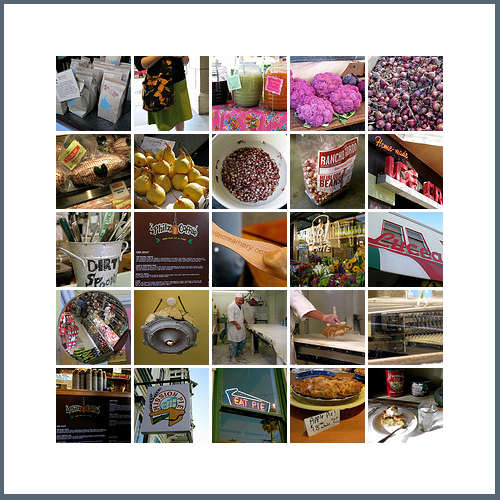
Oh, what fun we’re having with Laura, eating our way around the Ferry Plaza and The Mission from sunrise to sunset, then cooking up a storm for the first night of the Dark Days challenge. The three of us (with the dogs, naturally) sat up gabbing until almost midnight, telling stories and talking about… food, duh!
I promise a thorough recap later, but for now you can check out my Flickr set — plus Laura’s Flickr set and post on (not so) Urban Hennery — for a quick peek at our day.
Dark Days challenge, farmers markets, other blogs, shopping, The Mission
3 Comments »




Posted by Anita on 11.12.08 9:42 PM
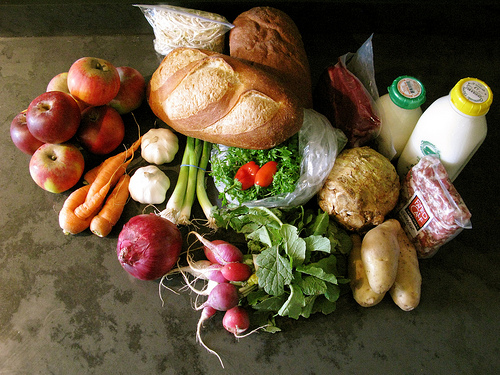 The image above is last weekend’s shopping haul, one of a series of similar photos I’ve been taking each Saturday since early summer. Inspired by my friend Jen’s beautiful shot of her farmers market purchases prettily laid out on a kitchen table in the cool spring light, I’ve started documenting what we’re buying each week. I flatter myself that it’s a fun Flickr set to flip through — overview shots of each week’s purchases all piled together, and a few solo portraits of our favorite finds — and an interesting way to keep track of the seasons. I can imagine referring to it next year (“Did we get corn in June or July?”) as a sort of visual seasonality calendar.
The image above is last weekend’s shopping haul, one of a series of similar photos I’ve been taking each Saturday since early summer. Inspired by my friend Jen’s beautiful shot of her farmers market purchases prettily laid out on a kitchen table in the cool spring light, I’ve started documenting what we’re buying each week. I flatter myself that it’s a fun Flickr set to flip through — overview shots of each week’s purchases all piled together, and a few solo portraits of our favorite finds — and an interesting way to keep track of the seasons. I can imagine referring to it next year (“Did we get corn in June or July?”) as a sort of visual seasonality calendar.
But, more than its mere utility, I’m struck by how beautiful the food we eat can be, especially in its natural state. Conventional wisdom holds that organic food is imperfect by nature, and uglier than the supermarket stuff. But after eating this way for the better part of two years, all I can see is the personality of our purchases. It’s perhaps a little too romantic to say that this aesthetic appeal is the direct result of the care that our farmers give their crops, and yet I do realize a lot of the variation I find so appealing — the huge with the tiny, the bright with the dull, the symmetrical with the misshapen — is part and parcel of the heirloom varieties and less-industrial methods that small-scale farming allows.
The set is a celebration of everyday beauty, the product of my brief meditation each Saturday on the wonders of the market. It makes me inordinately happy to lay out my week’s purchases on the counter, fuss with the arrangement, and set up the shot. Sometimes the light cooperates, and I end up with a subtly shaded image that’s like a Renaissance painting. Other times the spirit eludes me, and I end up with something less artsy and more documentary. Either way, I’m forcing myself to pay closer attention to mundane beauty, to wean myself from the fake perfection of the retail world.
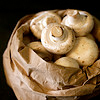


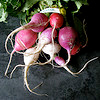
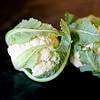
farmers markets, other stuff
11 Comments »




Posted by Anita on 11.08.08 8:44 PM
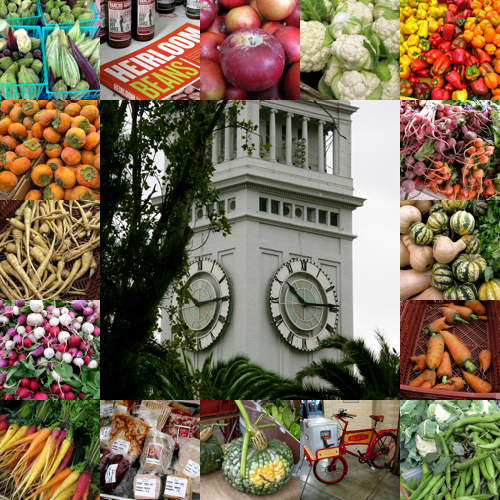
Not a lot to report — we’ll get back to real posts tomorrow — but I couldn’t help but share a few snaps from the Ferry Plaza market today. It was grey and chilly but sometimes the bright colors of our fall produce seem even prettier when set against a monochrome sky.
We arrived on the (very) late side, so we had to battle against the crowds. But I was like a kid in a candy store playing with my new toy: A Canon G9 camera. It’s a pocket-sized point-and-shoot model, but it comes equipped with lots of photo-geek features. I’m surprised how much fun I’m having using a zoom again, after the fixed lenses on my dSLR camera. One pleasant side effect is that I can take my weekly food still-life shots from overhead, instead of straight on. I’m not sure I’ll stick with that format forever, but it’s nice to have the flexibility.
I haven’t even cracked the manual yet, but I’m hoping the G9 will be swoopy enough that I can (mostly) leave the big camera at home for ‘studio’ work. We’re travelling to London next month, and it would be a pleasure not to have to haul the ‘big gun’ around with me on our daily adventures. People whose opinions I trust seem to love their G-series cameras, so I have high hopes.
farmers markets, geekery
5 Comments »




Posted by Anita on 11.01.08 2:36 PM
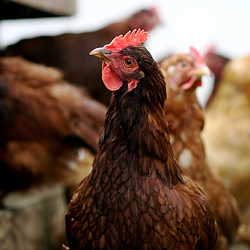 Last year, when I discovered — after reading Bonnie Powell’s excellent post — that the Judy’s Family Farm eggs I’d been buying at the Ferry Plaza Farmers Market were the product of an intensive factory operation called Petaluma Farm, I was pretty pissed.
Last year, when I discovered — after reading Bonnie Powell’s excellent post — that the Judy’s Family Farm eggs I’d been buying at the Ferry Plaza Farmers Market were the product of an intensive factory operation called Petaluma Farm, I was pretty pissed.
I first blamed CUESA, the market’s organizers, for allowing me to be duped. But soon I realized the real culprit was my own ignorance, and I directed my anger where it properly belonged. It was foolish, after all, to expect that all food sold at the Ferry Plaza market would meet some rudimentary ethical standard and that the products would be sold by, you know, actual small farmers. I really should have wondered how Judy’s managed to sell their eggs for a third of the price of Marin Sun or Eatwell, but I was blinded by the almighty bargain.
My frustration at having been deceived spurred me to pay closer attention to how the food — especially the eggs, dairy, and meat — we buy at the market is really grown. I spent the better part of 6 months asking a lot of questions, and I am sure some farmers got pretty sick of me. But when all was said and done, I was pleased to realize — with the exception of this one major blip in the egg department — that the Ferry Plaza was full of real farmers whose animal-care practices I can support in good conscience.
But now, with the attention CUESA has given Petaluma Farm as part of their coverage of Proposition 2 — the California initiative that would require all caged and crated animals the exceedingly modest consideration of being able to stand up, lie down, turn around, and extend their limbs — I feel I really must speak up and question their motives as an organization.
To put it in perspective: I realize that, as recently as last year, there weren’t enough pastured eggs to meet demand. Egg aficionados lined up before the market opened, and latecomers (or even on-timers) were often heard sighing over how they’d been beaten to the punch yet again. I’d like to think that the decision to permit this…. shall we say “less-than-ideal” vendor was a matter of filling in the gaps; local and quasi-free-range eggs are better than nothing. But now that Marin Sun, Eatwell, Marin Roots, and Soul Food offer a steady supply of pastured, humane egg options, I’m shocked that CUESA continues to allow large-scale, factory producers to sell at the Ferry Plaza market. There’s no excuse left that I can find.
But the thing that really sticks in my craw is that CUESA offered the bully pulpit of a prime feature spot in their weekly newsletter to the specious anti-Prop 2 arguments of Petaluma Farm’s Steve Mahr.
Mahr’s got a right to his opinions, and (for now at least) the legal freedom to cram as many laying hens into confinement as he sees fit. I’m glad to learn that he raises at least some fraction of his hens in a cage-free environment. But the hypocrisy of passing off his blatantly industrial product as the sustainable and humane gleanings of some idyllic family farm needs to be called out. And I’m absolutely furious that CUESA is letting it pass.
Mahr claims in the CUESA story that, “I will not be in business if Prop 2 passes.” To which I say: “It’s no worse than you deserve, you greenwashing jive-turkey.” At least the eggs sold at Safeway aren’t pretending to be anything other than the inhumane, factory-produced crap you’d expect.
Of course, pastured eggs are still a luxury that many shoppers can’t afford. But not everyone has room in their weekly food budget for pastured beef, either, and yet you don’t see CAFO meat at the Ferry Plaza. If CUESA is going to claim that one of the 10 reason to shop to shop at their farmers market is “to promote the humane treatment of animals … who have been spared the cramped and unnatural living conditions of so many of their brethren,” then that’s what should be offered, period. And they need to get on the bus and support Prop 2 without any ifs, ands, or buts.




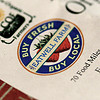
Pastured Eggs at the Ferry Plaza
Eatwell Farm
Nigel & Frances Walker
5835 Sievers Road
Dixon, CA 95620
organic@eatwell.com
866.627.2465
Marin Sun Farms
David & Julie Evans
10905 Highway 1
Point Reyes Station, CA 94956
david@marinsunfarms.com
415.663.8997
Soul Food Farm (at the Prather Ranch store)
Alexis & Eric Koefoed
6046 Pleasants Valley Road
Vacaville, CA 95688
soulfoodfarm@aol.com
707.469.0499
Marin Roots Farm
Jesse Kuhn
PO Box 74, Petaluma, CA 94952
info@marinrootsfarm.com
415.309.2474
More information about Proposition 2
Yes on Prop 2 official site
Michael Bauer (SF Chronicle)
Los Angeles Times (op-ed)
New York Times (endorsement)
Grist Environmental News
Oprah Winfrey Show
The Ethicurean
farmers markets, farms & farmers, locavore, other stuff
14 Comments »




Posted by Anita on 08.29.08 11:48 AM
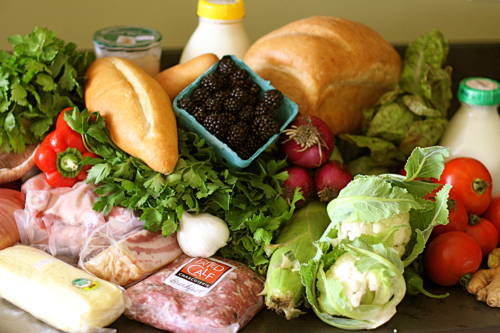
Our weekly shopping haul; One Local Summer, Week 13
—–
Unless you’ve been in a self-imposed media blackout, you may have heard about the party that Alice, Carlo, and friends are throwing here in Our Fair City. And you’d probably guess that a pair of diehard food dorks like us would be camped out in line, waiting for the chance to storm the gates first thing in the morning, wandering through the Victory Garden as we sample a continent’s worth of canapes in the dappled summer sun.
But the fact is, we live a Slow Food Nation life all the time. We spend practically every weekend grazing around the City and around the Bay Area. We live in a community where our oddball food choices have become fairly mainstream. We hang out with a crowd of thoughtful food-worshippers who can carry on a spirited debate about how to balance being a locavore with being a (small-c) chowhound.
We’re truly blessed to make our home here in the epicenter of the local, organic, sustainable food movement. San Francisco’s a city where it’s hardly a challenge at all to eat well and eat ethically… so much so that I get fairly bent out of shape when circumstances or travel force me to do otherwise.
So, no — No “Foodstock” for us. Happily, we have a lot to do this weekend:
– Buying our weekly groceries from the people who grow/make them
We do this every week at the Ferry Plaza Farmers Market, but just to make it interesting — and to bypass the frenzy of out-of-town foodies descending there this weekend — we’re heading across the bay to the Berkeley Farmers Market. We’ll see some of our usual vendors there, but I’m looking forward to exploring new stalls and new ingredients.
– Putting up food to preserve the harvest
Later in the day, we’ll pick up 100 pounds of San Marzano tomatoes at Mariquita Farm’s “guerilla veggie” drop-off. Later in the weekend, we’ll be hauling out the pressure canners and turning them into puree, marinara sauce, and whole canned tomatoes to feed us through the winter
– Supporting restaurants that support local farms
Mariquita’s making their drop at Piccino, so we’ll have a chance to experience their brunch for the first time. The fact that Sher and Wayne — like so many other San Francisco restaurateurs — procure so much of their raw ingredients from the same farmers and artisans that we buy from makes me inexplicably giddy.
– Exploring the food traditions of our neighbors
Saturday night, we’re heading out to a family-run ethnic restaurant with a group of food-obsessed friends. Later in the weekend — if we get our canning done — we’ll visit a Thai food festival put on by the local Buddhist temple at Golden Gate Park. Neither of these experiences are Slow, in the sense of using exclusively sustainable/local/organic ingredients, but supporting ethnic foodways is an essential part of being a citizen of our city and the world.
– Celebrating the bounty of our region
On Monday, we’re having some friends over for a little nosh. We’ll eat some pâté and peaches, sharp cheese and homemade plum chutney. We’ll drink local bubbly, sip homemade pear brandy, maybe even shake up a cocktail using artisanal spirits. Later there’ll be farmers-market pasta tossed with some of the marinara sauce we made earlier, maybe baguette slices spread with pesto. A pie, perhaps… made with a local-flour-and-butter crust (learned from a friend who also happens to be a local treasure) and filled with yet more amazing farmers market finds.
—-
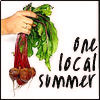 Am I conflicted about opting out of the Slow festivities? Absolutely. I’m already drooling over the Slow on the Go and Taste Pavilion tidbits showing up in friends’ Flickr streams. By all accounts, the Friday events have been beautiful, interesting, and delicious. I hope that they keep it up, because the people who’ve traveled here from all over the world deserve it. And so do the farmers, food-makers, and volunteers who are going all-out to make a fabulous impression.
Am I conflicted about opting out of the Slow festivities? Absolutely. I’m already drooling over the Slow on the Go and Taste Pavilion tidbits showing up in friends’ Flickr streams. By all accounts, the Friday events have been beautiful, interesting, and delicious. I hope that they keep it up, because the people who’ve traveled here from all over the world deserve it. And so do the farmers, food-makers, and volunteers who are going all-out to make a fabulous impression.
But on the other hand, I know we’ll make the perfect slow celebration, in all the ways that matter most to us, just as the folks visiting our city and our local producers will have theirs. Either way, I can’t think of a better way to celebrate Labor Day than by honoring the backbreaking effort — both physical and political — that our farmers and artisans spend to put quality food on our tables.
Bay Area, farmers markets, locavore, One Local Summer
18 Comments »




Posted by Anita on 06.22.08 4:30 PM
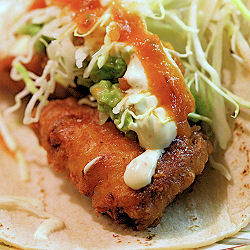 One day last week, I looked up from my work and was stunned to see it was nearly 2:30 in the afternoon. The day had screamed away from me, and — not surprisingly — I was ravenous.
One day last week, I looked up from my work and was stunned to see it was nearly 2:30 in the afternoon. The day had screamed away from me, and — not surprisingly — I was ravenous.
Local food choices near my office are pretty bleak, so I try to eat pescitarian when I can’t determine the source of my lunchtime chow. It’s an easy choice to make, since the mall near my office is home to one of the Bay Area’s only outposts of Rubio’s, a SoCal chain of Baja-style joints. Their #1 combo plate — two fish tacos and a side of frijoles — makes a reliable lunch in a pinch.
Usually, that is.
Unfortunately, the tacos I got that afternoon were pretty bad: The tortillas were falling apart, and the fish was smelly and dark. I pulled the offending meat out and ate my tacos veggie style, resolving to remember to bring my lunch the next day.
Rather than put me off, the whole experience just made me crave fish tacos — real ones, good ones — all the more. So come Saturday, we stopped by Shogun Fish at the Ferry Plaza farmers market and picked up a nice fillet of black rockfish caught off the Mendocino coast. I figured we’d be out of luck for local cabbage, but we found a gorgeous head over at Tierra‘s stand, where we also picked up a bag of super-smoky chipotles. Add in a pack of Rancho Gordo tortillas and a tub of Primavera salsa, and we were good to go.
Even if you think you don’t like seafood, a Baja-style fish taco is pretty easy to love. There’s not really anything mysterious about them: Batter-fried fish, wrapped in a corn tortilla, topped with shredded cabbage, salsa, and creamy white sauce.
To drink? Well, there isn’t a much better local alternative that good old Anchor Steam, brewed about 2 miles from our house. We used it in the fish batter, too, along with Guisto‘s flour, Stonehouse olive oil, and a Marin Sun Farms egg white. The traditional salsa blanca combines equal parts Clover Organic sour cream and home-made mayonnaise (from the same local eggs and oil), spiced up with the Tierra chipotles.
The result: My favorite kind of summertime food — good ingredients, simply prepared.



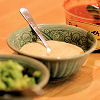

Baja-Style Crispy Fish Tacos
adapted from The River Cottage Cookbook
– fish:
1 large fillet of firm, white fish (about 12 ounces)
scant 2/3 cups all-purpose flour
1T olive oil
up to 6oz beer, as needed
1 egg white
oil, for frying
 – white sauce:
– white sauce:
1/3 cup mayonnaise
1/3 cup sour cream
1 or 2 chipotle chiles (canned or dry)
– to serve:
corn tortillas
1/4 head of cabbage, shredded fine
prepared salsa or taco sauce
cilantro sprigs, if desired
Mix the flour with oil, then thin it with beer to the consistency of thick paint. Season with salt and pepper, and leave at room temperature for at least an hour while you prep your other ingredients.
Cut your fish into 1-1/2-inch strips, against the grain of the fillet. Season with salt and pepper on both sides, and set aside.
For the white sauce, combine the mayo and the sour cream. If using dry chipotles, soak them in hot water for 15-20 minutes until soft, then chop to a fine paste with kosher salt. For canned chipotles, a simple mashing will do. Add the chipotle paste, to taste, to the sour cream-mayo mixture; season with salt as needed.
Heat oil in a deep-sided kettle or dutch oven to 350°.
Whip the egg white until frothy, then fold into the rested fish batter. Dip the fish pieces in the batter, shaking off any excess, and gently lower them into the hot oil. (You may need to work in multiple batches to avoid crowding the pan; be careful not to allow the oil temperature to drop.) When golden brown, remove from the oil with a spider or slotted spoon. Place the fish on a wire rack over old newspaper while you fry the remaining pieces.
To serve, place a piece of fish in the center of a tortilla; top with white sauce, salsa, cilantro, and shredded cabbage as desired.
farmers markets, locavore, Mexican, One Local Summer
15 Comments »




Posted by Anita on 06.07.08 7:18 PM
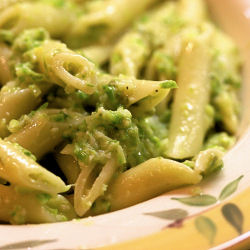 The weekend before last, I noticed a sign hanging from our favorite asparagus stand: “Last week at the market!” Stunned, I quickly grabbed a bunch of fat spears, as though somehow I could prolong the inevitable if I only moved fast enough. I laughed at myself as I paid the farmer, then sighed every time I opened the bag to put something else in: the… last… asparagus. It’s just impossible to believe that this quintessential spring vegetable is already done.
The weekend before last, I noticed a sign hanging from our favorite asparagus stand: “Last week at the market!” Stunned, I quickly grabbed a bunch of fat spears, as though somehow I could prolong the inevitable if I only moved fast enough. I laughed at myself as I paid the farmer, then sighed every time I opened the bag to put something else in: the… last… asparagus. It’s just impossible to believe that this quintessential spring vegetable is already done.
Truthfully, I’ve eaten my fair share of asparagus this spring: Baptized in butter and lemon juice, wrapped in pancetta and roasted, kissed by the smoky love of the grill, shaved raw and stacked with Parmesan shards, pureed into an ethereal chilled soup, topped with a poached egg and sprinkled with buttery breadcrumbs. Truly, my love of sparrow grass knows no bounds; I think nothing of eating it every time I see it on a menu.
But no matter how often I indulge, I’m never ready to see asparagus go. Given my obsession, you’d think — any reasonable person would — that I’d have run home from the market and enjoyed my haul before the dew was dried from its tips. But no, I’m a miser: I squirreled it away, wanting to prolong my personal asparagus season as long as possible.
Maybe I was in denial that the end was near. What other plausible explanation can there be for the fate of that prized bunch of the season’s last spears? Dear readers, forgive me: I left them in the produce drawer all week. Completely and utterly forgot about them, until the weekly fridge-cleanout exposed my error.
 All’s well that ends well, though. Less-than-perfect asparagus gets a new lease on life when whizzed into a savory spring pesto, which in turn makes a more-than-perfect dinner for the inaugural week of One Local Summer. This summertime locavore challenge asks participants to cook a weekly meal from 100% local sources. A stunning 136 participants representing 30 states are joining the festivities, hosted by Farm to Philly with West Coast recaps from a familiar face: Laura at Urban Hennery.
All’s well that ends well, though. Less-than-perfect asparagus gets a new lease on life when whizzed into a savory spring pesto, which in turn makes a more-than-perfect dinner for the inaugural week of One Local Summer. This summertime locavore challenge asks participants to cook a weekly meal from 100% local sources. A stunning 136 participants representing 30 states are joining the festivities, hosted by Farm to Philly with West Coast recaps from a familiar face: Laura at Urban Hennery.
Even between challenges, we’ve still been eating locally as much as we can — nearly every meal we cook at home is made from 85-95% locally grown or locally produced foods. But since One Local Summer only asks us to document one meal a week, we’re going to be stricter on ourselves than we have been in the past. We’ll source everything (even proteins) from within 100 miles, and our only exceptions will be salt and spices. Herbs, oils, sweeteners, even beverages will all come from our immediate foodshed.
—–
But back to the pesto: You might think that a meal made from over-exposed produce and a few pantry staples might taste like a thrown-together mess, but in all honesty nothing could be further from the truth. A judicious removal of all fibrous or discolored bits, followed by a brightening blanch in well-salted water cures a lot of ills when it comes to green veggies. It was our favorite meal of the week, and then some: Cameron and I fought over the leftovers, a sure sign of a recipe that’s bound for heavy rotation — I only wish we’d discovered it sooner.
Along with the neglected Zuckerman asparagus, our pesto contained a good lashing of Bariani’s sumptuous olive oil, a blizzard of Vella dry Jack cheese, sweet blanched almonds from Alfieri Farms, and beautiful young garlic — not quite green, but with still-supple skins and a glorious round flavor — from Green Gulch Farm. Served over Eduardo’s locally made penne, these bright flavors balanced perfectly with the earthy, smoldering notes of Fatted Calf‘s coiled Basque sausage and a fruity bottle of Souverain sauvignon blanc.
A fitting farewell to spring if I do say so myself.

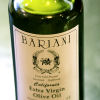
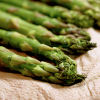
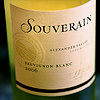
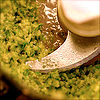
Penne with Asparagus Pesto
1 bunch asparagus (about 1/2 pound before trimming)
8 oz dry penne pasta
1/4 cup blanched almond slivers
2 medium garlic cloves
1/4 teaspoon salt
1/4 cup extra-virgin olive oil
1 ounce freshly grated Dry Jack (about 1/3 cup), plus more for garnish
Fill a Dutch oven or other large pot with water. Salt well, and bring to a boil. Meanwhile, prepare an ice-water bath in a medium bowl.
Snap the woody ends from the asparagus. Cut the stalks into 2-inch lengths, keeping the tips separate. When the water comes to a boil, blanch the stem pieces until they turn bright green and tender, then remove them to the ice bath using a slotted spoon. Repeat with the tips, which should take about half as long. Keep the pot boiling for the pasta while you drain the chilled asparagus well and blot it dry.
In a food processor, pulse the almonds, garlic, and salt until minced, scraping down the sides of the bowl as needed. Add the asparagus and oil, pulsing until the mixture is coarsely chopped — you’re not going for a smooth purée here. Remove the blade from the work bowl, and add the grated cheese. Stir until combined, and season to taste with salt and pepper.
In the same pot of boiling water, cook the penne until al dente. Reserve about 1/3 cup of the pasta water, then drain the pasta. Return the empty pot to the stove over low heat, add the pesto to the pot, then add the drained penne and enough pasta water to create a sauce. Toss well to coat. Taste and season again with salt and pepper as needed.
Serve in shallow bowls, with more grated cheese sprinkled on top.
farmers markets, Italian, locavore, One Local Summer, other blogs, recipes
11 Comments »




 After two-plus weeks in London, we knew it was going to be difficult to get back to the grind, and the cold, grey weather here in San Francisco wasn’t doing anything to help us get over our jetlag.
After two-plus weeks in London, we knew it was going to be difficult to get back to the grind, and the cold, grey weather here in San Francisco wasn’t doing anything to help us get over our jetlag. We certainly had no problem finding meat. Marin Sun Farms was there, as were the Prather Ranch boys and Devil’s Gulch Ranch — a name we’ve seen on menus, but never bought; they don’t sell at the SF markets. By the time we arrived, all they had left was a big five-pound pork shoulder roast. We hemmed and hawed, then decided that we could make a big batch of carnitas and save the leftovers for a later meal. A vendor from San Luis Obispo — technically outside our challenge radius, but we fudged it — was selling avocados, and a bakery from Sacramento had corn tortillas; we’d made the right decision.
We certainly had no problem finding meat. Marin Sun Farms was there, as were the Prather Ranch boys and Devil’s Gulch Ranch — a name we’ve seen on menus, but never bought; they don’t sell at the SF markets. By the time we arrived, all they had left was a big five-pound pork shoulder roast. We hemmed and hawed, then decided that we could make a big batch of carnitas and save the leftovers for a later meal. A vendor from San Luis Obispo — technically outside our challenge radius, but we fudged it — was selling avocados, and a bakery from Sacramento had corn tortillas; we’d made the right decision.















































